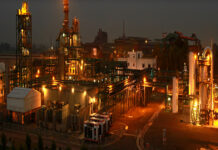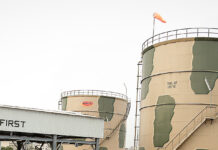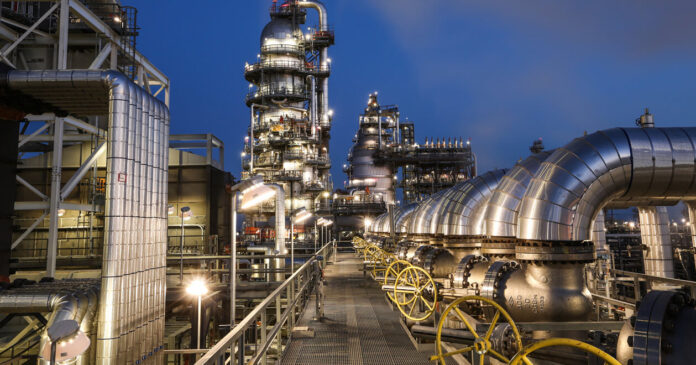It is raining in Karachi this week. As any Karachi-wala can tell you, this is not an occasion for joy. And it was certainly not an occasion of joy for Pakistan Refinery Ltd (PRL), one of the six oil refineries operating in Pakistan, and one of the four located in Karachi. In fact, it rained, quite literally, on Pakistan Refinery’s parade.
On August 25, on account of torrential downpour, rain water washed away a portion of a piles bridge, which is a type of bridge that has long poles in the ground, that form the foundations of the bridge. Piles bridges have been around since the Middle Ages, but are uncommon these days, simply because mankind has discovered better bridge techniques (yes, in case you are wondering, Pakistan Refinery is government-owned). This is relevant because, well, the rainwater damaged the piles bridge, and this particular piles bridge was carrying intracity oil pipelines which connect the refinery at Korangi Creek to the Keamari Terminal at the Karachi Port, from where it receives its shipments of crude oil imports.
For context, Keamari and and Korangi are on opposite ends of the city of Karachi, with Keamari being on the western part of the city, and Korangi towards the east. The pipelines are 16 kilometres long. There are three pipelines that connect the two, according to reports: one carries crude, another carries diesel and petrol, and the third carries finance oil.
In a notice to the Pakistan Stock Exchange, the company said that the incident had resulted in severely damaging the oil pipelines. Not only that, but access to the site is difficult. Still, the company said it is assessing the situation so the magnitude of the damage can be ascertained. This will enable it to “take required measures regarding safety and continuity of refinery operation in the present situation, which may include temporary shutdown of refinery operations.”
PRL said it will only be able to estimate a time period to restore the pipeline once the assessment is complete, and that it will inform the exchange then.
The first, is of course, the company itself. This is a pretty tough spot for Pakistan Refinery to be in. The company was founded in 1960, with the plant becoming operational in 1962. The design capacity of the refinery was initially 1 million tonnes crude oil per annum, which later reached 2.1 million annum. It is owned by Pakistan State Oil, which holds a 52.68% share in the company, while Shell Petroleum also holds some share.

The company has had an unsteady last few years. Since 2011, it has reported a loss in five out of the nine years since. In particular, the fiscal year 2019 was especially worrisome, with the auditors including a paragraph of ‘material uncertainty relating to going concern’ in their report. That year, the company had a loss of Rs5.82 billion, and a loss per share of Rs13.68.
At the time, the company had said 2019 had been marked by a slowdown in the country’s economic growth that had also impacted the oil refining industry. The steep devaluation of the currency had also not helped.
Things were only about to get worse in 2020. This year, the company had a loss of Rs7.59 billion, and loss per share of Rs17.74. Furthermore, it had accumulated loss of Rs18.36 billion, and its liabilities exceeded its assets by Rs16.84 billion.
“The above mentioned conditions may cast significant doubt on the company’s ability to continue as a going concern.”
What else is the cause of Pakistan Refinery’s woes? IN 2013, the government of Pakistan announced that oil refineries has to install a diesel hydroesuphurisation Unit (DHDS) by 2017 to produce high speed diesel which is Euro II -compliant. As of 2020, the company has still not set up the unit. That means that under the ministry of energy rules, it was subject to downward adjustment of its HSD pricing for all three years of 2018, 2019, and 2020. This caused a loss of Rs1.03 billion in 2020.

So, in short, it was not a great time for Pakistan Refinery’s pipeline to fall apart. According to reports, the refinery usually has seven to 12 days of stock, after which it might be difficult to keep the refinery operational, which might lead to the refinery being shut altogether.
This is a view echoed by Shahrukh Saleem, an equity research analyst at AKD Securities. “For PRL, that is a 16km long pipeline which carries crude oil from Keamari to Korangi. It is a main pipeline however the impact it will have on PRL’s production can only be ascertained once it is clear how much time it will require to repair,” he explained.
However, the company coils still pull through, according to Saleem. “PRL has 74,100 tons of storage capacity for crude oil at Korangi so for the short term, it might have enough reserves to continue production.”
According to A.A. Soomro, Managing Director at KASB Securities, this was a “force majeure unforeseen circumstances which can have the impact of disrupting the refinery value chain.”
He further said, “the company posted huge losses lately and any delayed operations could further put the company at risk.”


























Sir aslamualikum I am TiG welder from Karachi .I need job . you have job ? cantact nmbr 03329752992